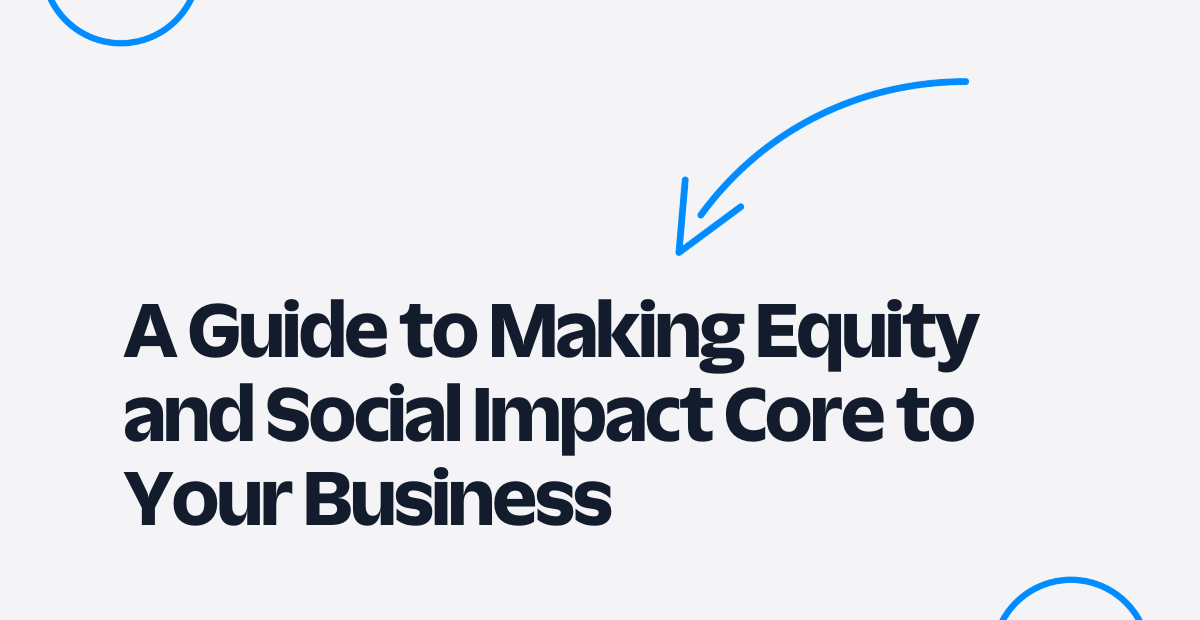A Guide to Making Equity and Social Impact Core to Your Business
Time to read: 6 minutes

For more than a decade, a movement to bring equity to the business world has been brewing. A tipping point arrived in 2020 when the COVID-19 pandemic and renewed focus on the Black Lives Matter movement, among other culture-shifting events, called individuals and organizations alike to dismantle inequities in every system.
In the time since, the for-profit world has sometimes struggled to meet evolving expectations around social good. But according to a recent study profiled in a Harvard Business School report, the urgency to do so is only growing. Their research found that:
- A majority of American consumers (55 percent) believe it’s important for companies to take a stand on key social, environmental, and political issues.
- Nearly 70 percent of employees say they wouldn’t work for a company without a strong purpose.
- 48 percent of investors have decided not to invest in a company because it lacks a strong purpose, while thirty-eight percent of investors have gone a step further and sold shares.
But what does that mean for you?
In short: post-2020, consumers, employees, and investors expect companies to rally behind causes that benefit all stakeholders, not just the bottom line. That can sound daunting, but tying equity and impact to the work you’re already doing is often more intuitive than you might expect.
In this piece, we’ll share insights from the SIGNAL 2021 Creator Summit on how three very different companies—Rothy’s, Lyft, and Twilio’s own social impact division—have made purposeful missions a part of their business strategy and provide actionable insights on how your company can do the same.

Aligning your business with social impact: Three examples across industries
Each of the leaders we spoke to at our SIGNAL social impact session have a unique perspective on what it takes to align a company’s mission with purpose-driven work: Head of Sustainability at Rothy’s, Saskia van Gendt; Director of Lyft’s social impact team, Lisa Boyd; and Twilio’s Chief Social Impact Officer, Erin Reilly.
Though these companies are situated in different industries, retail, consumer tech, and enterprise tech, the throughline among them is an intuitive alignment between social impact causes and the goods/services they bring to the market. Below, we’ll lay out how each found that alignment—and the positive impact doing so has had not only on those they serve, but on the broader success of their companies.
Rothy’s: Differentiating with sustainability
For Rothy’s,doing good through business was central from the beginning. They wanted to stand out in the notoriously unsustainable fashion space, so they were founded with a commitment to turn single-use plastic water bottles and ocean-bound marine plastics into beautifully designed footwear and accessories. Leveraging new manufacturing technology, Rothy’s knits each item with exactly the amount of material needed—removing waste from excess fabrics.
According to van Gendt, that mission has helped them grow, succeed, and differentiate in an incredibly crowded market. Rothy’s items are not only sustainably sourced and produced, but are intended to be timeless, durable, and washable, significantly extending their usability far beyond the competition.
“We give customers an opportunity to do good through the buying choices they make,” van Gendt said, which has propelled Rothy’s to not only be a massively successful business—but one that makes an even greater impact as it scales. Since its launch five years ago, Rothy’s has given new life to millions of water bottles with virtually no waste along the way.
Lyft: Driving equity via core transportation services
For Lyft, a rideshare service used by millions each year, the question of bringing purpose into their work meant examining how transportation plays a crucial role in an equitable society.
Rather than opt for a more general path, Lyft decided to use their unique superpower—the ability to provide access to transportation—to make an impact on people’s lives. “My team identifies the acute moments, such as getting to a job interview or getting to a COVID-19 vaccine appointment, where transportation access can be transformational to that individual or that community,” Boyd said.
Through their LyftUp programs, Lisa’s team provides donated or discounted rides to those in need during critical moments. For example, it was estimated that 15M+ people did not vote in the 2016 election due to lack of transportation, so Lyft launched a Voting Access Program to help hundreds of thousands of Americans get to the voting booth in both 2018 and 2020. This program also drove substantial business value through press attention, social media engagement, celebrity support, and more.
Twilio: Aligning social impact with business growth
Twilio’s position in the digital communications space provides a unique opportunity to build impact directly into the company business strategy: Twilio’s communication building blocks for SMS, WhatsApp, Video, Voice and more enable nonprofit organizations to reach the people they serve and deliver the right help at the right time.
Twilio.org is the social impact business unit of Twilio, which offers nonprofits access to a suite of communication services at a discounted rate. With this revenue, Twilio is then able to offer grants, allocate employee volunteer time, and more services to help other social impact organizations access technology to scale their mission. “We have what we call our go-to-market virtuous cycle,” Reilly explained. “The more nonprofits accomplish their mission through Twilio technology, the more we can invest in helping nonprofits scale their impact .”
This cycle ensures that Twilio is integrating social impact into its broader business goals—so rather than asking for resources to drive social impact programs, these programs organically scale as the company’s revenue grows.
"The most effective way to increase impact and create long-term business value is to make the social impact organization a source of revenue."—Erin Reilly, Twilio Chief Social Impact Officer
Best practices for building social impact into your business
Start with a mission in mind
For a company like Rothy’s, a key to success has been the clear, unwavering mission they tied to their business from the start. If you can launch a company with your vision for social impact already in place, you’ll be getting an invaluable head start.
That said, not every company today was built with social impact woven into its DNA—but it’s never too late to assess how your work can make a difference in the lives of others.
“It’s harder to retrofit an established company if you don’t have sustainability integrated from the very beginning,” van Gendt said, but there are still options to explore, “like smaller product launches to test the waters.”
Anticipate and adapt to challenges
When a business encounters tumultuous circumstances, it can seem difficult to continue prioritizing social impact work. But a company or industry-wide crisis—or in recent years, a global crisis—can often present some of the best opportunities to merge impact and business value.
When the world stopped in the early days of the COVID-19 pandemic, Boyd recalls the rideshare industry facing incredible uncertainty. But it also presented Lyft with an opportunity to consider their role in the greater good. “Our drivers essentially became front line workers helping get the world back on its feet,” she said.
Rather than break under pressure, they resolved to double down on making the world a better place through transportation; Lyft quickly launched a delivery service in partnership with nonprofits and local governments to provide food for communities. “We delivered over 2 million free meals in 6 months and helped put money directly into drivers’ pockets at a key moment,” said Boyd.
This example shows that when a challenge presents itself, social impact and responsibility can often be a way to help sustain a business—not something that detracts from it.
Influence leaders to prioritize equity
Though today’s rapid shift toward equity has been years in the making, many leaders are still familiar with a paradigm in which impact work was merely an accessory to the core mission. Getting their buy-in means making impact an inextricable, revenue-generating part of your business.
“I’ve been in social impact for over 20 years, and one fundamental truth is that anytime social impact comes into conflict with the need to generate profit, it loses,” Reilly explained. “The most effective way to increase impact and create long-term business value is to make the social impact organization a source of revenue.”
Now is the time to prioritize impact
The insight of these leaders makes it clear that tying impact, equity, and sustainability to your business is not only the right thing to do, it can be incredibly rewarding and possible no matter the industry.
Considering your role in doing good will go a long way toward meeting the expectations of stakeholders, driving revenue, and establishing a clear brand identity.
Related Posts
Related Resources
Twilio Docs
From APIs to SDKs to sample apps
API reference documentation, SDKs, helper libraries, quickstarts, and tutorials for your language and platform.
Resource Center
The latest ebooks, industry reports, and webinars
Learn from customer engagement experts to improve your own communication.
Ahoy
Twilio's developer community hub
Best practices, code samples, and inspiration to build communications and digital engagement experiences.


